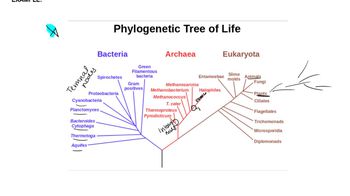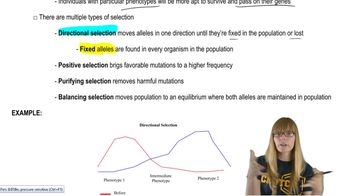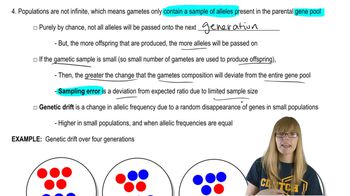Table of contents
- 1. Introduction to Genetics51m
- 2. Mendel's Laws of Inheritance3h 37m
- 3. Extensions to Mendelian Inheritance2h 41m
- 4. Genetic Mapping and Linkage2h 28m
- 5. Genetics of Bacteria and Viruses1h 21m
- 6. Chromosomal Variation1h 48m
- 7. DNA and Chromosome Structure56m
- 8. DNA Replication1h 10m
- 9. Mitosis and Meiosis1h 34m
- 10. Transcription1h 0m
- 11. Translation58m
- 12. Gene Regulation in Prokaryotes1h 19m
- 13. Gene Regulation in Eukaryotes44m
- 14. Genetic Control of Development44m
- 15. Genomes and Genomics1h 50m
- 16. Transposable Elements47m
- 17. Mutation, Repair, and Recombination1h 6m
- 18. Molecular Genetic Tools19m
- 19. Cancer Genetics29m
- 20. Quantitative Genetics1h 26m
- 21. Population Genetics50m
- 22. Evolutionary Genetics29m
21. Population Genetics
Allelic Frequency Changes
Problem 33a
Textbook Question
Evaluate the following pedigree, and answer the questions below for individual IV-1. Is IV-1 an inbred individual? If so, who is/are the common ancestor(s)?
 Verified step by step guidance
Verified step by step guidance1
<insert step 1: Understand the concept of inbreeding. Inbreeding occurs when individuals that are closely related genetically produce offspring. This often involves mating between relatives such as cousins.>
<insert step 2: Analyze the pedigree chart. Look for any loops or connections that indicate a common ancestor between the parents of individual IV-1.>
<insert step 3: Identify the parents of individual IV-1 in the pedigree. Trace their lineage back to see if they share any common ancestors.>
<insert step 4: Determine if there is a common ancestor. If both parents of IV-1 can be traced back to the same individual(s) in previous generations, then IV-1 is considered inbred.>
<insert step 5: Identify the common ancestor(s). If a common ancestor is found, note who they are in the pedigree chart. This will help confirm the inbreeding status of IV-1.>
Recommended similar problem, with video answer:
 Verified Solution
Verified SolutionThis video solution was recommended by our tutors as helpful for the problem above
Video duration:
3mPlay a video:
Was this helpful?
Key Concepts
Here are the essential concepts you must grasp in order to answer the question correctly.
Pedigree Analysis
Pedigree analysis is a method used to study the inheritance patterns of traits in families. It involves creating a diagram that represents family relationships and the presence or absence of specific traits across generations. By analyzing the pedigree, one can identify whether traits are inherited in a dominant, recessive, or sex-linked manner, which is crucial for understanding genetic conditions.
Recommended video:
Guided course

Pedigree Flowchart
Inbreeding
Inbreeding refers to the mating of individuals who are closely related genetically, which can increase the likelihood of offspring inheriting genetic disorders. In a pedigree, inbreeding can be identified by the presence of multiple connections between individuals, indicating shared ancestors. This concept is important for evaluating the genetic health of a population and understanding the potential risks associated with inbreeding.
Recommended video:
Guided course

Non-Random Mating
Common Ancestors
Common ancestors are individuals from whom two or more individuals in a pedigree are descended. Identifying common ancestors is essential for determining inbreeding, as it reveals the genetic links between individuals. In the context of pedigree analysis, recognizing these ancestors helps assess the genetic diversity and potential health implications for the descendants.
Recommended video:
Guided course

Phylogenetic Trees

 5:58m
5:58mWatch next
Master Natural Selection with a bite sized video explanation from Kylia Goodner
Start learning



